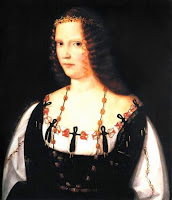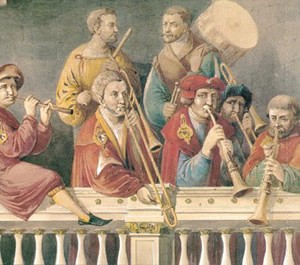Cattle die, kindred die,
Every man is mortal:
But I know one thing that never dies,
The glory of the great dead.
Hávamál,
trans. W.H. Auden and P.B. Taylor
Really?
I've been thinking about the concept of
fame lately, viz. who's famous and who's not. This is mostly in the
context of writing historical fiction, an area in which a
longstanding debate continues to simmer: must a book have what some
call a “marquee name” to sell, or is that not necessary? Agents
and publishers largely seem to favor having someone in your book who
everyone's heard of, whether that person is the main character or
not, but various surveys and informal discussions suggest that this
may not be as important to readers as it is to publishing
professionals.
I don't want to wade in to this
particular debate, which appears to be set to continue indefinitely.
But I am starting to wonder exactly what constitutes a “marquee
name.” And I've concluded that one person's famous person is
someone else's “Huh?”
Part of this wondering comes from my
own writing experience. While I can't remember a time when I didn't
know the story of the headstrong knight Buondelmonte, the jester
whose prank provoked him, and the cavernous split between the Guelfs
and Ghibellines that resulted, I have had to come to grips with the
fact that most people have absolutely no clue who these people were.
 |
| Buondelmonte, slain |
Yes, they're mentioned in every
contemporary chronicle; yes, some of them are in Dante's Divine
Comedy; yes, Machiavelli cites
the incident in his history of Florence. But it's understandable
that modern Americans would not know the tale, unless they have, as I
do, a particular interest in Italian history. And heaven knows there
are plenty of people others consider famous who I've never heard of.
You can't be an expert in everything, no matter how many crossword
puzzles you work.
And it's entirely
possible that a book about, say, Betsy Ross would occasion nothing
more than a shrug from an audience outside the U.S.
But I have long believed that
Buondelmonte is a household name in Italy, or at least in Florence,
and now I'm not so sure.
What has made me doubt? I was reading
about the making of Woody Allen's latest film, To Rome With Love.
It's said that Allen hated that
title. He wanted Bop Decameron,
which makes perfect sense to me. But apparently when they tried it
out on various groups of people, including Italians, nobody got it.
 |
| Boccaccio |
Okay,
so maybe not so many people have actually read Boccaccio's
masterpiece. I'd have to say they're really missing something, but
so be it. That title wouldn't work.
So
next they tried Nero Fiddled.
And, believe it or not, nobody got that.
 |
| Nero |
They don't know
about Nero? And his fiddle (even if it was probably a lyre)? And
Rome burning? Even in Italy?
Well,
then, who exactly is
still famous?
If you throw in the
preference many agents and publishers have for historical fiction
written from a woman's point of view, you are then trying to identify
the available field of women in history who an audience – an
American audience, let's say – would actually know something about.
 |
| The Big Three |
That,
I figure, would be the Big Three. Cleopatra, Eleanor of Aquitaine,
and Anne Boleyn (described by a well-known literary agent as “the
poster girl of historical fiction”). Check 'em out. You won't
find any shortage of books about any of these three women.
But
surely people know about other famous women, you say. Well, yes,
probably; these runners-up would get high marks for recognizability:
 |
| Runners-Up |
They
would be Queen Elizabeth I, Queen Victoria, and Marie Antoinette. Of
those, Queen Victoria probably graces fewer books than the other two,
but at least people know her name. After all, she and Elizabeth each
had a whole age named after them. Marie Antoinette, of course,
shares with Al Gore the predicament of being famous for a
particularly dippy statement that she/he never actually said. (Hint:
one of them advocated eating cake, and the other invented the
internet.)
But
I wanted to explore this idea of who's famous and who isn't, to see
if I could make any sense of it. In the course of checking to see
where a particular Italian was buried, I checked a fascinating site
called Find a Grave. I went to the Italy version, and was interested
to learn that they had two categories of well-known people interred
somewhere in Italy: Very Famous, and Somewhat Famous.
(This reminds me of Miracle Max, in the movie The Princess Bride: "It just so happens that your friend here is only MOSTLY dead. There's a big difference between mostly dead and all dead." I think there must be a big difference between Very Famous and Somewhat Famous, too.)
So
I scanned Very Famous. I was expecting to find Dante there; how
could the great poet not be Very Famous? I mean, he's so famous that
people who've never read his work pretend they have. It doesn't get
much more famous than that.
Dante
is not there.
Boccaccio
is (remember Boccaccio?). Enrico Caruso is. Luciano Pavarotti (or
“Provolone,” as my former co-worker insisted on calling him) is
there. Saint Francis of Assisi is there. Igor Stravinsky is there.
(Yes, I know he's not Italian, but he is buried on Venice's funeral
island.) And three guys who were awarded the Victoria Cross for
their military heroism are there.
Very
famous? Three men, no doubt heroic and in all ways laudable, but one
of whom earned his award in a war
I hadn't even heard of? (No, I'm not going to tell you which one
that was.) More famous than Dante?
I
don't think so.
So
I checked out Somewhat Famous. Dante did at least make it to
Somewhat Famous, I was relieved to see, but his presence there and
that of some of his co-listees still surprised me. Is Saint Benedict
really that much less famous than Saint Francis? Is Lucrezia Borgia
really less famous than Marcello Mastroianni? And how is it that
Boccaccio and Caruso and Elizabeth Barrett Browning all managed to be
both Very Famous and Somewhat Famous? If they could do it, why
couldn't Dante?
 |
| Caruso |
 |
| Lucrezia Borgia |
It
appears that there is a sort of voting system, a popularity contest,
if you will, to determine levels of fame for this site. And poor old
Dante only gets 4.5 stars out of a possible five. He must have been
required reading for too many people.
On
this site it is possible to leave messages for the deceased, as well
as to post virtual flowers and candles, other appropriate pictures,
and holiday greetings. Thinking that this might tell me something
useful, I scanned the 204 notes various people have left for Dante.
Since
I've taken a special interest in Gemma Donati, Dante's wife, I was
pleased to see this one:
Happy
Easter to you. (♥ Beatrice and Gemma also ♥)”
Hardly
anybody seems to wish Gemma a happy Easter these days, so I was
pleased. (She isn't any flavor of famous, at least not until I get
my next book finished.) But my favorite was the note from the
librarian looking for a good illustration from the Inferno so she
could use it for a tattoo. I can think of some real doozies; wonder
which she chose? There are some great ones by Botticelli, who was
Very Famous.
If
that's the best that Italy's great poet could do, I thought, I wonder
how Shakespeare fared? Over to England we go...
…and
you will be pleased, Gentle Reader, to learn that Shakespeare is Very
Famous. Not only that, he merited no fewer than 900 notes, the most
outstanding of which said “You write good plays, Shaky.”
 |
| Shaky |
So we have people I think are famous who apparently aren't, and people I know nothing about who apparently are, and yet we are supposed to be writing about marquee names.
Is
it any wonder we historical fiction writers get frustrated sometimes?
I personally enjoy finding the obscure stories; they haven't been
done to death. And as a reader, I love finding out about people and
places and times that never really crossed my radar screen before. I
read the Author's Notes. I look things up to find out what's real
and what's invented.
And
if the writer is really good, then maybe, just maybe, someone who I
knew nothing about before becomes just a little more famous – maybe
even enough to oodge her (or him) up to Very Famous.
Images
in this post are all in the public domain.















.jpg)











_c.1330_220x245cm._Pinacoteca,_Vatican..jpg)

_-_WGA8395.jpg)

